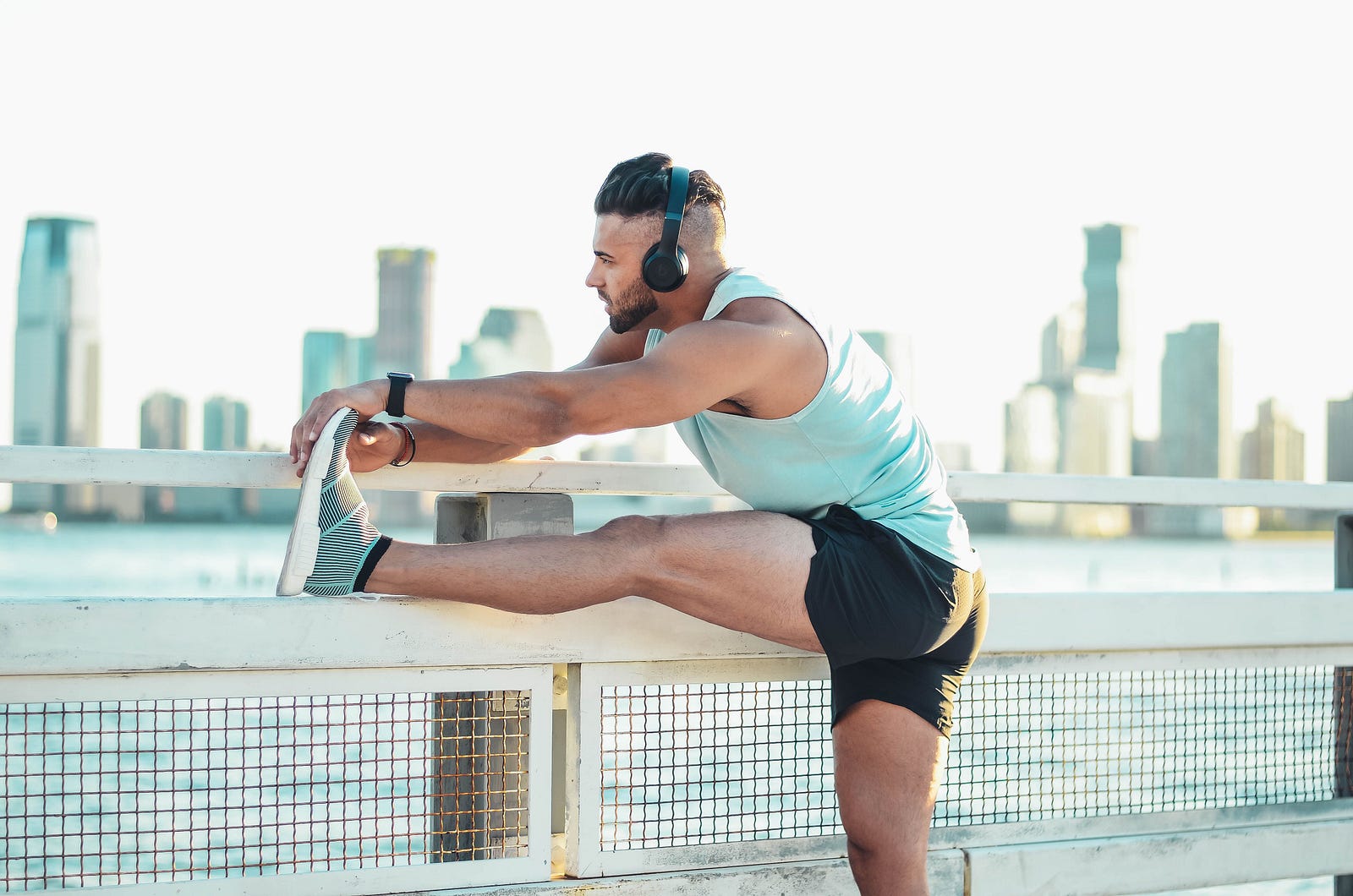TO STRETCH OR NOT TO STRETCH BEFORE A WORKOUT? Whether you need to stretch before your workout depends on your workout type and fitness goals. Stretching can be beneficial to your health in numerous ways. Here are some of the potential benefits of stretching:
- Improved flexibility and range of motion: Regular stretching can help improve your flexibility and range of motion, making it easier to perform daily tasks and physical activities.
- Reduced risk of injury: By improving your flexibility and range of motion, stretching can also help reduce your risk of injury during physical activities.
- Increased blood flow and oxygenation: Stretching can help increase blood flow and oxygenation to your muscles, which can help them function better and recover more quickly after physical activity.
- Reduced muscle tension and stress: Stretching can help relieve muscle tension and stress, which can help you feel more relaxed and comfortable.
- Improved posture: Stretching can help improve your posture by releasing muscle tension and promoting proper alignment.
- Reduced risk of back pain: By improving flexibility and posture, stretching can also help reduce your risk of back pain and other types of muscular pain.
Incorporating regular stretching into your routine can be a simple and effective way to improve your overall health and well-being.
I have always believed that failing to stretch before and after doing physical activity is bad. Skipping my stretching would increase my chances of injury, soreness, and a suboptimal training session. Right?
Today we explore the science behind stretching before exercise. Should we always stretch before physical activity? The short answer is no; you may not need to stretch. The longer answer depends on your fitness goals and exercise type. Today we explore the impact of pre-activity stretching and performance.
“I have of late — but wherefore
I know not — lost all my mirth, forgone all custom of
exercises; and indeed it goes so heavily with my
disposition that this goodly frame, the earth, seems to
me a sterile promontory, this most excellent canopy,
the air, look you, this brave o’erhanging firmament,
this majestical roof fretted with golden fire, why,
it appears no other thing to me than a foul and pestilent
congregation of vapors. What a piece of work is a man!
How noble in reason, how infinite in faculties,
in form and moving how express and admirable,
in action how like an angel, in apprehension how like
a god! The beauty of the world, the paragon of animals!
And yet, to me, what is this quintessence of dust? Man
delights not me — no, nor woman neither, though by
your smiling you seem to say so.”
― William Shakespeare, Hamlet
Stretching types
Stretching techniques include the following types:
- Static
- Dynamic
- Ballistic
- Proprioceptive neuromuscular facilitation (PNF)
- Passive
- Active
Two of the most common forms include static and dynamic stretches. Static stretches involve holding a stretch comfortably, typically for 10 to 30 seconds. This approach may be most helpful following physical activity.
Dynamic stretches are active movements causing your muscles to stretch, with the stretch not held in the end positions. Many individuals prefer dynamic stretching to prepare muscles for movement before exercise.
To stretch or not to stretch?
My focus will be on static stretching, for which you hold still in a position to lengthen a muscle. Do you think that static stretching affects your performance during power and strength training?
Stretching has long been common in recreational and competitive athletic training. One clinical literature review examined the role of stretching in performance enhancement.

The review discusses the research regarding the effects of static, dynamic, and proprioceptive neuromuscular facilitation stretching on performance in three categories of sporting activity: strength- and power-dominant, speed- and agility-dominant, and endurance-dominant activities.
Despite the regular incorporation of stretching into training programs, researchers are still determining the efficacy of the practice. Most research suggests that static stretching has no effect on — or may harm — strength and power training. Power training includes movements such as jumps or explosive lifts to develop speed and strength.
Here are the provocative conclusions of the authors:
The evidence suggests that it is reasonable to recommend against static stretching immediately before power and strength activities. However, if a general warm-up or dynamic stretching is done after static stretching, any negative effect on strength and power performance might be reduced.
On the other hand, most studies find that dynamic stretching before a strength-dominant activity is helpful. Fewer studies demonstrate a negative effect on the performance of dynamic stretching.
The researchers note that the evidence regarding proprioceptive neuromuscular facilitation (PNF) before strength- and power-dominant activities are mostly neutral or negative.
What about stretching before speed- and agility-dominant activities? Most of the available literature suggests this:
Pre-performance static stretching is detrimental to performance. However, similar to the effect seen with power-dominant activities, an intervening period of a general warm-up or dynamic stretching may reverse this negative effect. Moreover, dynamic stretching before speed- and agility-dominant activities appears helpful.
There is insufficient evidence to know the value (if any) of PNF stretching before speed- and agility-dominant activities.
Stretching and endurance activities
Static stretching has no effect or a detrimental one on endurance performance. The effects of dynamic stretching on endurance performance are unclear, as are those of PNF stretching before longer-duration endurance activities.
My take —To stretch or not to stretch (pre-activity)
In conclusion, dynamic stretching can be helpful for most athletes immediately before activity, with static and PNF stretching probably best left until after activity completion (if used).
Suppose you choose to do static or PNF stretching before the activity. In that case, follow it with some dynamic stretching (for five minutes or so) or a general warm-up before your workout to eliminate any potential negative effects of stretching on performance.
Here are some general guidelines:
- If you have a medical condition or injury, check with your doctor or physical therapist before starting a stretching routine.
- A short stretching routine can help warm up your muscles and prevent injury if you are about to engage in physical activity. It is more important to move a bit to get warm.
- If you have a job or lifestyle that involves prolonged sitting or standing, stretching can help alleviate muscle tension and improve flexibility.
- If you are feeling stiff or sore, stretching can help relieve muscle tension and promote relaxation.
In general, stretching can be a useful tool for maintaining flexibility, improving the range of motion, and promoting relaxation. However, it’s important to use proper technique and avoid overstretching, which can lead to injury.
If you’re unsure about stretching properly, consider consulting with a certified personal trainer or physical therapist who can provide guidance and recommendations tailored to your needs.
When it comes to athletic performance, static stretching before a workout doesn’t seem to add value and may be detrimental to performance, but incorporating dynamic stretching may be better.

How to Get the Most Benefits From Stretching
Stretching is the deliberate lengthening of muscles to increase flexibility in the muscles and range of motion…www.verywellfit.com
Stretching may not always be safe:
- If you have an injury, only do healthcare provider-recommended stretches. If your injury is chronic, consider chatting with a physical therapist or sports medicine specialist to get a tailored stretching protocol.
- If you have physical limitations that stop you from properly doing a stretching exercise, please reach out to a medical professional for alternative flexibility-improving exercises.
- No ballistic stretching. Avoid bouncing (unless guided by a fitness professional such as a physical therapist).
- Know your limits. Don’t push beyond the point of comfort. Tension, yes; pain, no. And don’t overdo it; over-stretching may cause damage.
- Get warmed up. Going into stretches cold can lead to injury. I stretch after my workout (or warm up for five or 10 minutes by walking or slowly jogging before stretching).
Remember: A dynamic workout is not a ballistic one. Try not to bounce. I add static exercise after exercise to reduce my injury risk and increase my flexibility.
I will end with the advice of Eduardo De Souza, an associate professor of health sciences and human performance at the University of Tampa (USA):
“First, you should raise your body temperature with a warm-up — light jogging, jump rope, or light cycling, for example. And then you rehearse the movements for what comes next.”
The information I provided in this blog is for educational purposes only and does not substitute for professional medical advice. Please consult a medical professional or healthcare provider if you seek medical advice, diagnoses, or treatment. I am not liable for risks or issues associated with using or acting upon the information in this blog.
Thanks for reading “To Stretch or Not to Stretch?” Here are some ideas for stretching:




